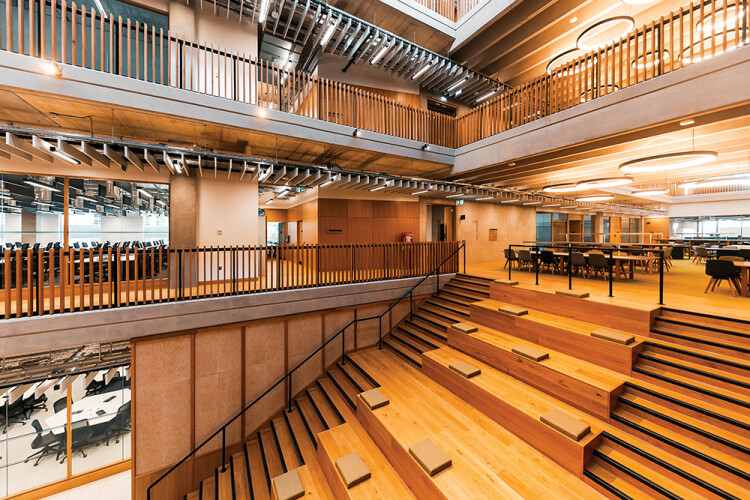If exposed concrete is going to be one of the main architectural features of your building project, you naturally want the finish to be top-notch. So imagine Jack Brooker’s disappointment when the concrete on one of the first sections of his project turned out looking decidedly sub-par.
Brooker is senior building manager for contractor Willmott Dixon and his project was Birmingham University’s new School of Engineering, designed by Associated Architects.
Delays affecting the vehicles transporting concrete to site, combined with poor compaction, caused a cold join to form within a concrete stair core in the basement, spoiling the appearance of the £50,000 section.
Brooker, who was responsible for all of the exposed concrete features across the project, says: “Exposed visual concrete was a crucial part of the overall architectural vision, centred around a four-storey atrium at the heart of the building, and there were extremely high specification requirements for the concrete finishes throughout.
“One of the key aims, and part of the educational vision, was to expose the building’s frame in as many areas as possible – columns, beams, atrium, stairs, bridge sections as well as specialist features. So it was critical that the look of the concrete was excellent.
“I think it’s fair to say that this was not the start that anyone had hoped for, particularly given that the building was set to be the home of some of the UK’s leading engineering research talent for many years to come.”
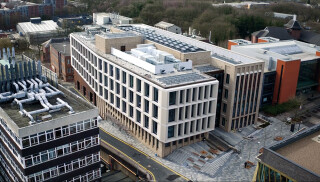
Various options were considered to rectify the problem, and given the high standard of finish required, the drastic step of demolishing and reconstructing the entire section – more than 400m2 of concrete in total – was definitely on the table.
But although this would probably have done the trick, it would have been expensive and environmentally reprehensible and would have resulted in significant delays at the very start of the 12-month project.
Brooker therefore looked for other options and eventually found the solution in the UK arm of German concrete repair specialist Betocare.
Launched in 2005 by professional painter and restorer Eduard Wenz, the Bonn-based company specialises solely in aesthetic remedial work on exposed concrete. The UK arm, headquartered near Oxford, was set up by brothers James and Martin Lewis in 2012 and is the only company outside Germany licensed to use the Betocare products and methods.
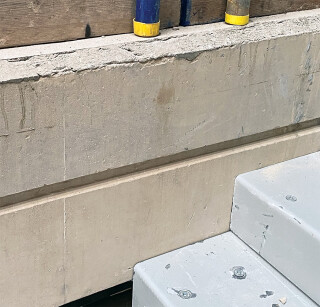
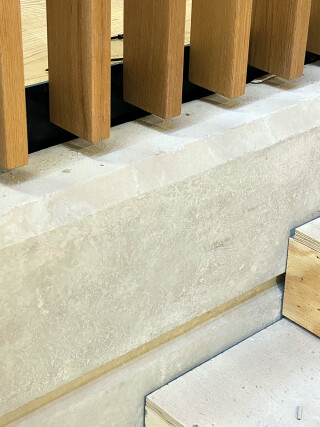
“When we first visited the site, there was, understandably, considerable concern,” says James Lewis. “The finish of the section was poor and there was a very visible undulating line all along one concrete section. However, such issues are common problems, and I immediately knew it was one that we could easily remedy.”
After an initial consultation the Betocare team carried out a small test sample in situ to demonstrate what could be achieved. The results were examined by no fewer than five clerks of work from the university who, in consultation with the Willmott Dixon team, agreed that they had found the best way to resolve the issue.
“There was an immediate sense of relief amongst the team,” says Brooker. “We’d found a solution that our client was not only happy but delighted with. The Betocare approach meant that we had avoided the need to knock down a perfectly structurally sound core.”
Once the Betocare approach had been agreed, it was then a case of waiting until the later stages of the project, when the building was watertight, before starting work. This also allowed all of the project’s visual concrete work to be assessed and any additional issues included in Betocare’s remit if necessary.

In the summer of 2020, after a thorough inspection of all the concrete, Betocare started work on site. Although the main works took place in the cores, there were a few localised concrete improvement works throughout the building on a smaller scale.
Betocare says it can rectify the full range of common concrete imperfections, from water damage and staining to cold joints and faults, as well as post-construction damage or errors such as misplaced bolt holes. In addition to the original problem section of the basement core cold joint, Betocare addressed many of these common issues as part of its work on the project.
The Betocare treatment involves the application of neutral colour repairs to surface irregularities that can then be intricately colour-matched to the surrounding concrete. As the colourisation takes place when the repair area is dry, the colour match can be exact and typically invisible to the naked eye, says Lewis.
“Take, for example, a visual crack or multiple cracks to an aesthetic surface: the initial phase of work to such a problem would first involve resin injection and repair of the cracks up to a maximum width of 6mm.
“Once the resin has cured, the concrete surface would then be removed along the cracks by approximately 5mm in depth to remove the resin stain from the surface. The concrete face is then rebuilt using lime- and silica-based fillers and colourised so that the repairs are rendered invisible. The finished columns would then be sealed with a bespoke graffiti-sealant, which ensure that the original concrete aesthetic is maintained,” he explains.
“Betocare were great to work with at a time when there was a lot of pressure to stick to schedule,” says Brooker. “For example, we had a very tight window to get the concrete work completed in the main atrium before the underfloor heating was installed, and only a few days’ use of the cherry picker needed for the work. If there had been delays, it would have had a significant knock-on effect.
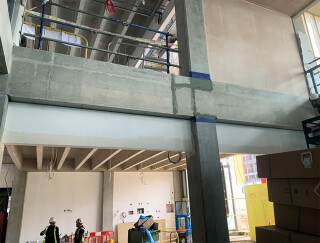
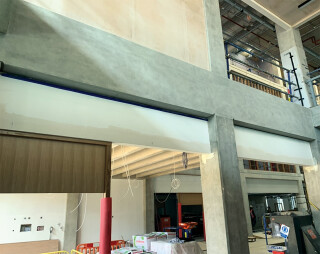
“Overall, I would say that we saved a six-figure sum by using Betocare to resolve the visual concrete issues we had, and that doesn’t include the financial costs that would have been associated with the considerable delays we would have seen with other, more traditional, resolutions to the problem,” says Brooker.
Although concrete repair is a whole industry sector in itself, Lewis says that the market for high-end visual and architectural concrete improvement is “surprising uncrowded..”
“Betocare UK is unique in terms of the approach, techniques and products that it employs – to the extent that the company is often asked to undertake work internationally,” says Lewis.
“In recent years, this has involved high-profile projects in Dubai, Cyprus, Los Angeles and the Caribbean, as well as Dublin, London and Birmingham.”
The company has worked with several internationally-renowned architects, including Zaha Hadid and David Chipperfield, and on high profile projects including Tate St Ives, the Gagosian Gallery in London and Chipperfield’s Faylands House in Buckinghamshire (voted
‘best house in the world’ in 2015 by the Architectural Review).
Lewis says that the demand for his type of remedial cosmetic treatment in architectural concrete is becoming increasingly popular, although he admits that adoption of more “innovative and considered” approaches is still “remarkably slow given the considerable economic and environmental benefits on offer”.
He adds: “Arguably the key barrier is a lack of awareness in certain pockets of the construction sector, sometimes teamed with a lack of understanding as to the integrity of the end result; the approach discussed here typically has a durability equal to the original concrete.
“Many people still have quite outdated perceptions around this type of work, and what
is possible.”
Got a story? Email news@theconstructionindex.co.uk

